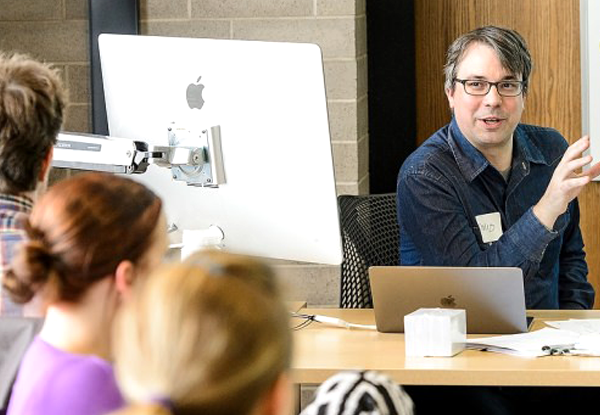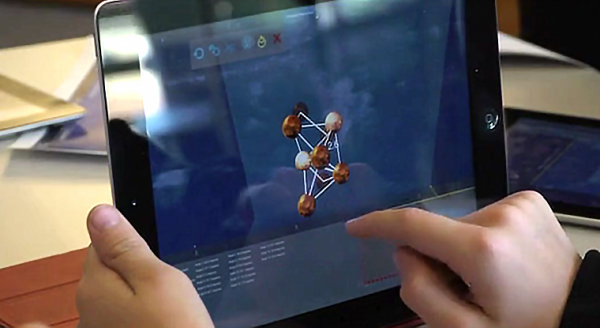Teacher Fellowship to Game Designer
Field Day Lab inspires learning in teachers and students with interactive media
July 5, 2017 | By Paul Baker

David Gagnon sits at the teacher’s desk during a classroom visit, which informs how he builds systems to advance education.
Teachers from across Wisconsin eagerly join a fellowship wait list to learn how to create digital educational games that engage students and boost learning.
These fellowships for K-12 teachers, which include face-to-face, virtual and hands-on learning, are available through the Field Day Lab, a digital media learning laboratory at UW–Madison’s Wisconsin Center for Education Research.
Field Day designers, engineers, researchers, teachers, artists and storytellers develop apps and games for educators and subject experts to help them engage their students in learning. The lab also develops large-scale distribution partnerships to ensure the games are played, allowing education researchers to study how students learn from digital media, and to connect education research to the public.
Fellows design and construct subject-specific games that fit into their curriculum. They reflect on what they teach, read and discuss academic literature, collaborate with UW–Madison faculty and staff, and produce games that will help other teachers.
“Prior to my fellowship, I would have said that video games are powerful instructional tools because they draw from students’ interests and experiences,” says Sarah Sprangers, a science and literacy teacher in the Middleton-Cross Plains School District. “While I still believe this to be true, I now recognize that their effectiveness extends beyond student engagement.”

Science-based games offer interactive digital tools so students can try activities like testing the properties of magnetism, mixing elements to create atoms or identifying forces that cause earthquakes.
Field Day Director David Gagnon says many educational games never get used because they aren’t online. Instead, games produced under research grants get archived when grant money ends. “The researchers wrote a paper, and publishing in a journal was the only goal all along,” he says.
In contrast, the Field Day Lab posts and maintains games players can access from anywhere. The Yard Games, for example, teach about the carbon cycle, water cycle and magnetism. Students have fun building a hot air balloon, learning how earthquakes develop and figuring out how nitrogen atoms move around the world.
The molecular simulation AtomTouch allows learners to explore principles of thermodynamics and molecular dynamics in a tactile, exploratory way. Players tap on prompts in a dialog box to add a sodium or a chlorine molecule to a group of atoms, change the size or temperature of the room, and then watch as the atoms respond.
Field Day staff check a digital map that shows, in real time, where kids all over the country are playing its games. “Our games are doing really well,” Gagnon says, “and they’re growing. There’s something like 3,000 plays a day.”

Bringing researchers, content experts and teachers together is why the games succeed. Field Day Lab staff know teachers and students will use them. “We want the games to be designed with teachers so the games connect with the curriculum and fit with what the teachers want,” Gagnon says. “At the same time, we want to transform what teaching IS. So there’s a push-pull in there, and we want to know, how far can we push it?”
Each semester, and during the summer, cohorts of teacher fellows learn game design theory through conversations similar to those in graduate school seminars.
Teachers who want to learn about game-based learning can apply for competitive fellowships that Gagnon says are far more productive than the usual professional development workshop.
“Our fellowships are selective,” he says. “We get two to three times as many apply as we accept. It’s a six-month commitment that includes implementing a game in their classes.”

Dominique Lark, a fourth-grade teacher and gamer since childhood, learned to design games as a fellow and then worked with Field Day science games. He uses learning games in his classroom every day.
And teachers appreciate the opportunity.
“The Field Day Lab Fellowship allows our school, our students and teachers like myself, to connect to the research of the University of Wisconsin–Madison,” says DeForest School District social studies teacher Beth Stofflet. “In our rural school district ... it’s often unclear how to link in to some of the learning opportunities on campus. The fellowship was a way for me and my students to be involved in new approaches to online interactive game design.”
Waunakee School science teacher Jessica North also has benefitted from connections made during her fellowship. The experience allowed her to “collaborate with other fantastic educators, learn more about the terminology and philosophy of gaming, and about material science.”
Ultimately, students benefit the most, Sprangers says. “Video games foster a learning environment where students co-construct knowledge and where it is encouraged that knowledge is dispersed among participants. Natural differentiation allows students to access knowledge at their own pace and assume a variety of identities and leadership roles.”
Gagnon sums it up. “Field Day games and apps try to capture the wonder, that pure excitement about the complexity and beauty of the world—that will determine how much we actually inspire kids with a love for learning."


